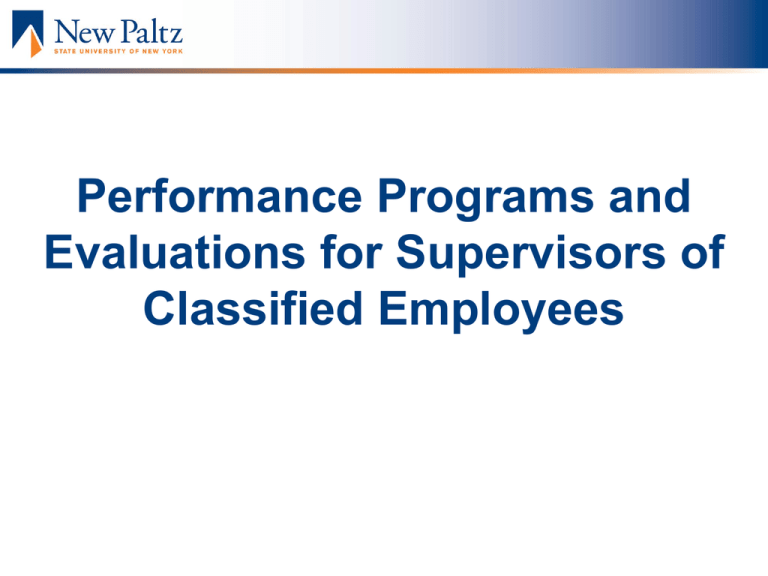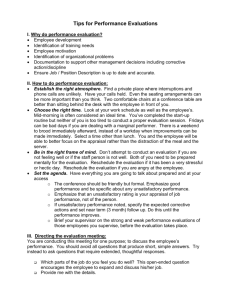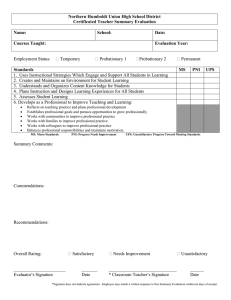Performance Programs and Evaluations for Supervisors of Classified Employees
advertisement

Performance Programs and Evaluations for Supervisors of Classified Employees AGENDA Performance Program, Probationary Period, Annual Evaluations • Definitions What goes into a Performance Program; how is it used (for annual evaluation)? How to write tasks in a Performance Program: • • What is to be done; To what; How/Why/When/Where? Discuss examples of well-written and poorly written objectives The probationary period: setting employees up for success: • • • Regular feedback Coaching Follow-up The annual performance evaluation • • Includes “no surprises” – it’s a summary of the prior year’s performance, taking into account regular feedback and coaching Satisfactory or Unsatisfactory “Wow, I’m so excited for my performance appraisal today!” said no one, ever. • • • Performance Program Probationary Period Annual Performance Evaluation What’s the difference? Performance Program • • Outlines objectives for employee to complete during the probationary period and annually Basis for performance evaluation Probationary Period • • Final step in the selection process Opportunity to evaluate an employee on knowledge, skills, and ability not evaluated by other parts of the selection process. Evaluation is based on the Performance Program. Annual Performance Evaluation • • Completed once a year for employees who have successfully passed the probationary period Based on Performance Program Performance Program • • • • • Hiring process Duties and responsibilities Classification Standard Revisions Basis for the Annual Performance Evaluation • Hiring process • Staff Appointment Request Form • No Performance Program for temporary employees unless Provisional Specific Measureable The Performance Program Timebound Reasonable The tasks should reflect operational needs and must encompass the whole job, starting with the most important. Task statements should consist of 3 components: 1. What is done (the action) i.e., “Prepare cover sheet” 2. To what i.e., for Vacancy Report 3. Qualifiers (How, Why, When, Where, etc.) i.e., “on a daily basis,” “weekly” Task Examples Bad: Sweep hallways. Sweep hallways as needed. Good: Sweep hallways on a daily basis. Hallways must be kept free from debris at all times. Better: ? Bad: Assist students and parents with problem resolution. Good: Assist students and parents within 24 hours with problem resolution inquiry by email, phone, or mail. This requires applying up-to-date knowledge of regulations and current issues. Demonstrated knowledge and customer satisfaction will be the criteria of evaluation. Key Points in the Performance Program: • Reporting relationships • Functional relationships • Spell out tasks, responsibilities and duties • Use the correct title • Specify the evaluation period • Signatures The Probationary Period • Crucial-Permanent • Time varies • Evaluations every 2 months • Specific and clear • Notification sent to employee when complete Inaction is An Action! Set Up Your Employees for Success! • Give feedback regularly (e.g., weekly, monthly) • Give feedback to address specific performance issues • Coach your employees to improve performance • Use the tools that are available (e.g., additional training, providing examples, demonstrating proper methods for tasks, counseling) You don’t need to micro-manage, but you do need to actually supervise so you know how the employees are doing, and what you can do to help them improve! Meet With Your Employees Regularly Schedule regular meetings with your employees to discuss assignments and performance • If you have pre-scheduled meetings on a regular basis your employees will have less of that “going to the principal’s office” feeling when you meet with them. • Even 15 minutes every week, month or quarter can increase productivity and save you time by avoiding major issues later. Meet With Your Employees Regularly This frequent formal and informal interaction with your employees should be an open communication. • It should not be a one-way street, in either direction. • Building walls in communication with your employees will hurt both of you. Keep in Mind… If an employee is not told that his/her performance is unacceptable, the employee will probably assume that is acceptable. • Do not assume that an employee knows something needs to be changed unless you specifically tell them. If you observe something, don’t think, “I’ll file that away and bring it up during the formal evaluation.” Address it immediately. • You have to have the difficult conversations. Doing nothing is not an option and putting it off will only make it worse. Any counseling of your employees should be behind closed doors, not in a public setting. Feedback, Coaching and Follow-Up Keep an ongoing record of your interactions and of the performance of each employee. It must be kept in a secure area and should include: • • • • Dates and details of incidents, conversations, and meetings Training or conferences the employee attends Specific examples of good and poor performances Important accomplishments, positive feedback, “happy letters,” etc. Again, don’t just sit on these and wait for the annual evaluation, go over them with the employee periodically (ideally at the regularly scheduled meeting). Follow-up is a key part of this process. If you discuss an issue with an employee in a meeting, check on it and provide informal feedback before the next meeting. Feedback, Coaching and Follow-Up This ongoing record is meant to help you remember specific dates and details. • If you need to give a counseling memo, you will have the dates of incidents and interactions accurately recorded and they can be added to the memo. This ongoing record will not, I REPEAT, WILL NOT be admissible during any formal process. Feedback, Coaching and Follow-Up For any Notice of Discipline or appeal of an evaluation, the only file that will be reviewed and referenced is the official employee file in Human Resources. • Everything in the official file has been presented to, and signed by, the employee (if the employee refuses to sign we use the alternatives laid out in the contracts) and can be reviewed by the employee by appointment. • If you did not present a counseling memo (which is constructive, not punitive) to the employee, you will not be able to reference those behaviors and interactions to support a notice of discipline or an unsatisfactory evaluation. • You must be able to verify that the employee was made aware of the behavior and given an opportunity to correct it. The only acceptable verification is the content of the official employee file in HR. Teamwork is the ability to work together toward a common vision. The ability to direct individual accomplishments toward organizational objectives. It is the fuel that allows common people to attain uncommon results. Andrew Carnegie Make sure you record and discuss the good things too! • The last thing you want to do is turn your meetings into “This is a list of things you did wrong since our last meeting.” • If the employee excels at something, acknowledge it. • If the employee improves on or corrects something you asked them to address, acknowledge it and thank them for addressing it. • You don’t have to use the “praise sandwich” method but make sure you talk about the good and the bad and give the employee an opportunity to address his/her concerns. Remember, this should be a dialog. Preparing for the Annual Evaluation 1. Let the employee know that his/her formal evaluation is coming up and schedule a meeting time. 2. Ask the employee to provide you with a written summary of his/her accomplishments for the year before you complete the evaluation – You are not asking them to write their own evaluation, just getting some highlights 3. Review your supervisor notes for the year. 4. Review the performance plan for accuracy for the next evaluation period. Performance Evaluations should be done annually Performance Evaluations must be accurate! The first things an arbitrator or outside agency will ask any employer for are Performance Evaluations and write-ups. Far too often they find an employee who was terminated for poor performance, but has no counseling or discipline on file and glowing Performance Evaluations. You should give your evaluation careful consideration and be sure it accurately reflects the employee’s performance. If it does not, it may come back to haunt you. No Surprises! The formal written written evaluation should be the formal expression (summary or recap) of the ongoing evaluation process. • It is not the time to bring up any new issues. Any specific areas of concern should have been handled as they developed through the counseling process. Each employee’s Performance Evaluation must have an overall rating of either “Satisfactory” or “Unsatisfactory.” • Employees have the right to appeal “Unsatisfactory” ratings. • Before you give an “Unsatisfactory” rating, ask yourself: – “Can I verify that the employee was made aware of their poor performance (counseling memo) and given an opportunity to correct it?” If the answer to this question is not a clear yes, the “Unsatisfactory” rating will likely be overturned. – Keep in mind that failing to address underperforming employees will reflect on you as a supervisor. You don’t want to have to tell your supervisor that an “Unsatisfactory” rating was overturned because you didn’t do the necessary work to support the evaluation. – It is highly recommended that you consult with Human Resources before you present an “Unsatisfactory” evaluation to your employee. Presenting the Written Evaluation • Double-check your work before you meet with the employee. • Start on a positive note. Acknowledge improvements and accomplishments. • Discuss the specific points of the evaluation. These should generally mirror the Performance Program they are based on. • Discuss future goals, both for the employee and the department as a whole, and specific plans to achieve those goals. This process should be used as a development tool, as well as an evaluation tool. • Conclude on a positive note, focusing on the future. 1. After presenting the evaluation, inform the employee they have the right to respond to the evaluation in writing, and have this response attached to the evaluation in their Official Personnel File. 2. If the overall rating is “Unsatisfactory”, inform the employee that they have the right to appeal the rating. • The time limit and appeal method vary by contract but in general an employee has 10-15 days from when they receive the written evaluation, and the appeal goes to specialized panel. 3. Both you and the employee should sign the evaluation. The employee signature is to indicate they received and discussed the evaluation, not that they agree with it. 4. After each of you sign the evaluation, make a copy for the employee and another for your records. The original should be forwarded to Human Resources in a Confidential Envelope. Rinse and Repeat Now it is time to complete the Performance Program for the next evaluation period and continue the process. Performance Program/ Evaluation Process Quick Reference-Classified Service Employee starts a position March 15, 2015 If significant changes to tasks occur before the end of the evaluation period, prepare and present a revised Performance Program to the employee. Prepare Performance Program utilizing old performance plan from previous employee, classification standard and goals for the department. List most important tasks first and expectation for performance and behavior. On or before March 15, 2016, prepare evaluation, meet with the employee for their input, schedule a time and discuss. Sign and return completed evaluation to Human Resources. Update or affirm Performance Program for the next performance period (2016/2017). Discuss with employee and employee should initial then send to Human Resources. If the employee is on probation in new position, prepare probation report every 2 months for the duration of the probation period.

